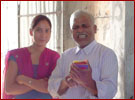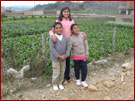| Health |
Indicatorsá |
| % of population using improved drinking-water sources, 2004, total |
90 |
| % of population using improved drinking-water sources, 2004, urban |
96 |
| % of population using improved drinking-water sources, 2004, rural |
89 |
| % of population using adequate sanitation facilities, 2004, total |
35 |
| % of population using adequate sanitation facilities, 2004, urban |
62 |
| % of population using adequate sanitation facilities, 2004, rural |
30 |
| % of routine EPI vaccines financed by government, 2006, total |
18 |
| Immunization 2006, 1-year-old children immunized against:, TB, corresponding
vaccines: BCG |
93 |
| Immunization 2006, 1-year-old children immunized against:, DPT,
corresponding vaccines: DPT1▀ |
93 |
| Immunization 2006, 1-year-old children immunized against:, Polio,
corresponding vaccines: DPT3▀ |
89 |
| Immunization 2006, 1-year-old children immunized against:, Polio,
corresponding vaccines: polio3 |
91 |
| Immunization 2006, 1-year-old children immunized against:, Measles,
corresponding vaccines: measles |
85 |
| Immunization 2006, 1-year-old children immunized against:, HepB,
corresponding vaccines: HepB3 |
69 |
| Immunization 2006, 1-year-old children immunized against:, Hib,
corresponding vaccines:Hib3 |
- |
| Immunization 2006, % newborns protected against tetanus? |
83 |
| % under-fives with suspected pneumonia taken to an appropriate health-care
provider▒, 2000-2006* |
43 |
| % under-fives with suspected pneumonia receiving antibiotics▒, 2000-2006* |
25 |
| % under-fives with diarrhoea receiving oral rehydration and continued
feeding, 2000-2006* |
43 |
| Malaria 2003-2006*, % under-fives sleeping under a mosquito net |
- |
| Malaria 2003-2006*, % under-fives sleeping under a treated mosquito
net |
- |
| Malaria 2003-2006*, % under-fives with fever receiving anti-malarial
drugs |
- |
DPT3 - Percentage of infants that received three doses of diphtheria,
pertussis (whooping cough) and tetanus vaccine.
HepB3 - Percentage of infants that received three doses of hepatitis B
vaccine.
% under-fives with ARI - Percentage of children (0-4 years) with acute
respiratory infection (ARI) in the last two weeks.
% under-fives with ARI taken to health provider - Percentage of children
(0-4 years) with ARI in the last two weeks taken to an appropriate health
provider.
Oral rehydration rate - Percentage of children under five with diarrhoea
in the last two weeks who received increased fluids and continued feeding
during the episode.
Malaria
% under-fives sleeping under a bednet - Percentage of children (0-4 years)
who slept under a bednet.
% under-fives sleeping under a treated bednet - Percentage of children
(0-4 years) who slept under an insecticide-impregnated bednet.
% under-fives with fever receiving anti-malarial drugs - Percentage of
children (0-4 years) who were ill with fever in the last two weeks and
received any appropriate (locally defined) antimalarial drugs.
Main data sources
Use of improved drinking water sources and adequate sanitation facilities
- UNICEF, World Health Organization (WHO), Multiple Indicator Cluster
Surveys (MICS) and Demographic and Health Surveys (DHS).
Government funding of vaccines - UNICEF and WHO.
Immunization - UNICEF and WHO.
Acute respiratory infection - DHS, MICS and other national household surveys.
Oral rehydration - UNICEF, MICS and DHS.
Malaria- MICS and DHS.
Notes
- Data not available.
x Indicates data that refer to years or periods other than those specified
in the column heading, differ from the standard definition, or refer to
only part of a country.
* Data refer to the most recent year available during the period specified
in the column heading.





